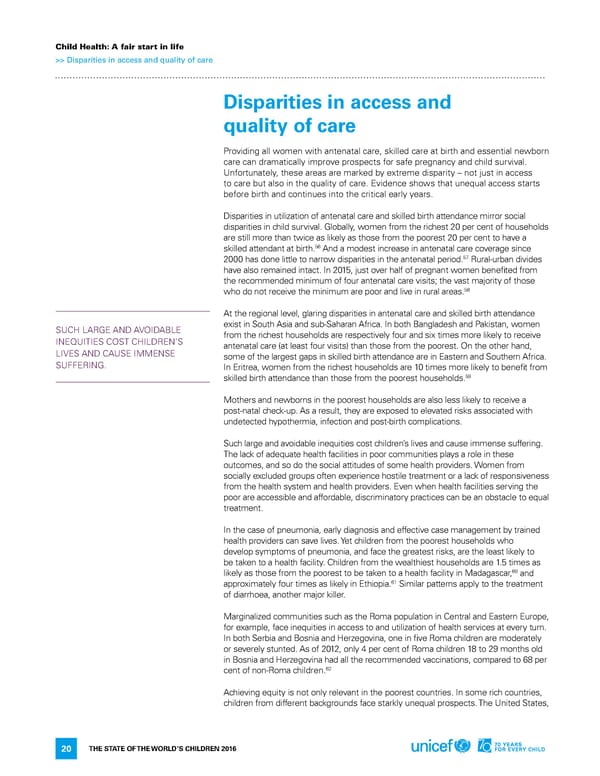Child Health: A fair start in life >> Disparities in access and quality of care Disparities in access and quality of care Providing all women with antenatal care, skilled care at birth and essential newborn care can dramatically improve prospects for safe pregnancy and child survival. Unfortunately, these areas are marked by extreme disparity – not just in access to care but also in the quality of care. evidence shows that unequal access starts before birth and continues into the critical early years. disparities in utilization of antenatal care and skilled birth attendance mirror social disparities in child survival. Globally, women from the richest 20 per cent of households are still more than twice as likely as those from the poorest 20 per cent to have a skilled attendant at birth.56 and a modest increase in antenatal care coverage since 2000 has done little to narrow disparities in the antenatal period.57 rural-urban divides have also remained intact. in 2015, just over half of pregnant women benefited from the recommended minimum of four antenatal care visits; the vast majority of those who do not receive the minimum are poor and live in rural areas.58 at the regional level, glaring disparities in antenatal care and skilled birth attendance SUCh larGe and aVoidaBle exist in South asia and sub-Saharan africa. in both Bangladesh and Pakistan, women ineQUiTieS CoST Children'S from the richest households are respectively four and six times more likely to receive liVeS and CaUSe iMMenSe antenatal care (at least four visits) than those from the poorest. on the other hand, some of the largest gaps in skilled birth attendance are in eastern and Southern africa. SUfferinG. in eritrea, women from the richest households are 10 times more likely to benefit from 59 skilled birth attendance than those from the poorest households. Mothers and newborns in the poorest households are also less likely to receive a post-natal check-up. as a result, they are exposed to elevated risks associated with undetected hypothermia, infection and post-birth complications. Such large and avoidable inequities cost children’s lives and cause immense suffering. The lack of adequate health facilities in poor communities plays a role in these outcomes, and so do the social attitudes of some health providers. Women from socially excluded groups often experience hostile treatment or a lack of responsiveness from the health system and health providers. even when health facilities serving the poor are accessible and affordable, discriminatory practices can be an obstacle to equal treatment. in the case of pneumonia, early diagnosis and effective case management by trained health providers can save lives. Yet children from the poorest households who develop symptoms of pneumonia, and face the greatest risks, are the least likely to be taken to a health facility. Children from the wealthiest households are 1.5 times as 60 likely as those from the poorest to be taken to a health facility in Madagascar, and approximately four times as likely in ethiopia.61 Similar patterns apply to the treatment of diarrhoea, another major killer. Marginalized communities such as the roma population in Central and eastern europe, for example, face inequities in access to and utilization of health services at every turn. in both Serbia and Bosnia and herzegovina, one in five roma children are moderately or severely stunted. as of 2012, only 4 per cent of roma children 18 to 29 months old in Bosnia and herzegovina had all the recommended vaccinations, compared to 68 per cent of non-roma children.62 achieving equity is not only relevant in the poorest countries. in some rich countries, children from different backgrounds face starkly unequal prospects. The United States, The STaTe of The World’S Children 2016 20
 70 Years for Every Child Page 34 Page 36
70 Years for Every Child Page 34 Page 36